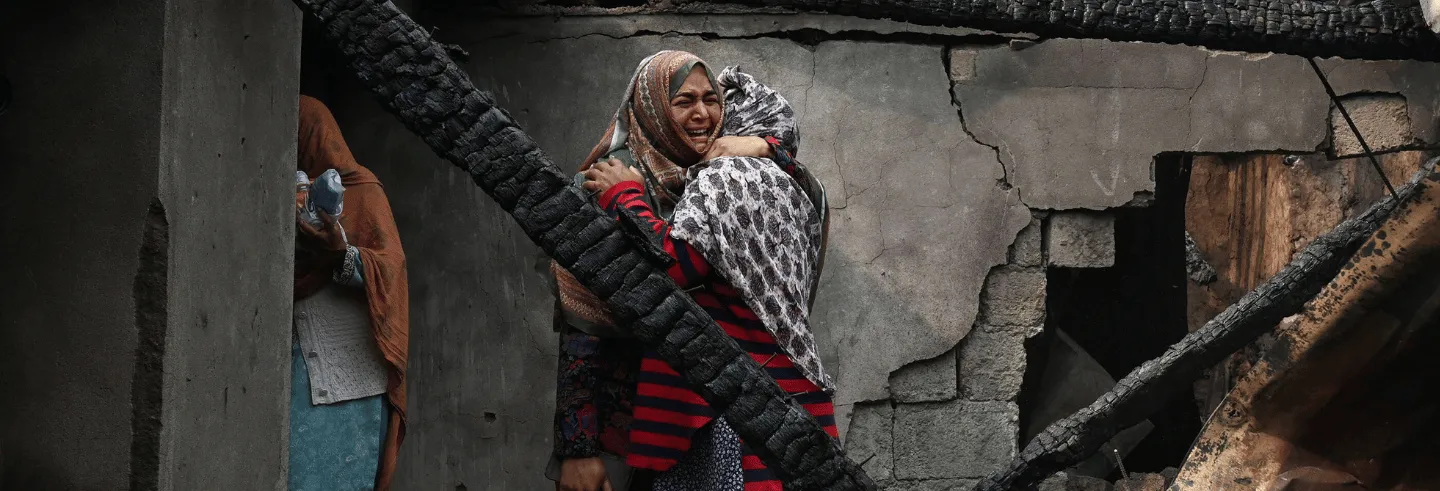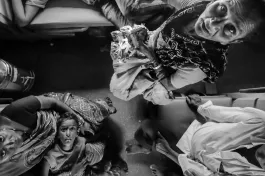The significance of an event—even if it is something as serious as war—depends on how it is interpreted and the perspectives from which it is judged. It is not the event itself, but the surrounding discourse that gives it meaning. Not surprisingly, people living in border areas, who have directly experienced shelling, firing, missiles, and drone attacks, view warfare very differently from those who have only seen selected footage of it on their televisions, sitting comfortably in homes far away.
No compensation, relief, or official visit can erase the trauma of those who directly experience the shock and violence of warfare.
To understand what happens to innocent people caught in the crossfire of conflicting armies, we need only to listen to Adil Pathan, who narrated how a tragedy had unfolded during shelling in the early hours of 7 May in Poonch district of Jammu and Kashmir. The maternal uncle of 12-year-old twins, Zain Ali and Urwa Fatima, Adil received a call from them asking him to help them get out of the town. They were in a rented house with their father Rameez, a school teacher, and mother Ursha Khan. He rushed out to help the family. When he called out as he approached the house, Rameez and the twins hurried out. At the very moment, a shell exploded very close by, killing the twins immediately and gravely injuring the father.
Whether a long, limited, or short war, there is really only one choice for civilians in a war zone—to do all they can to save their lives. As French philosopher and mystic Simone Weil wrote about war in an essay on the Iliad, “The true hero, the true subject, the centre of the Iliad is force. Force employed by man, force that enslaves man, force before which man’s flesh shrinks away.” Force is what turns anybody who is subjected to it into a “thing”.
Weil observed that though many may have expected that force would have become a thing of the past, it had not happened till 1945, the year she was writing. Neither has it since. “Exercised to the limit,” she wrote, “it turns man into a thing in the most literal sense: it makes a corpse out of him.”
Whatever be the causes and consequences of a conventional or sub-conventional war between India and Pakistan, it was certainly traumatic for the people living along the border separating the two countries. The killings of civilians, and the destruction of their homes and livelihoods have deep physical and psychological implications—nothing is going to be the same again for these people. As an aunt of the twins, Maria Khan, said after the cessation of hostilities, “Now, whether there is a war or ceasefire, our children will not come back.”
These words are powerful because the so-called “limited” war between India and Pakistan from 7 to 10 May 2025 deeply affected all vulnerable communities living in border areas. No compensation, relief, or official visit can erase the trauma of those who directly experience the shock and violence of warfare. It is unlike anything those who only read about it will experience.
Civilians Pay the Price
International law and basic human ethics dictate that civilians should never be targeted in an armed conflict between nations. While political and military leaders often claim to respect this principle, reality tells a different story. Since World War II, targeting civilian populations has increasingly become a deliberate tactic in warfare—used to strike at a perceived vulnerability or to break the enemy’s will. Despite being explicitly prohibited, civilians are attacked with disturbing frequency—as punishment for being in enemy territory, as a way to force submission, or even simply out of frustration. This happens even though civilians typically have no role in shaping policy or decisions about war.
In social media discussions about the potential conflict, the lives and property of those living in border areas were often given less importance compared to city dwellers.
In the US campaign against Japan in World War II, the killing of civilians did not begin with the dropping of atom bombs on Nagasaki and Hiroshima in August 1945. It began much earlier—in the firebombing of Tokyo on the night of 9-10 March 1945, which killed more than 100,000 people. Fast forward a few decades, and tens of thousands of civilians were killed in the US-led invasions on Afghanistan and Iraq, while innumerable people were maimed and injured and the livelihood of millions destroyed. Ironically, the claim was that these wars were being waged to improve the lives of the local population.
The recent hostilities between India and Pakistan brought home yet again that for people living in border areas, war offers absolutely no possibility of benefit or positive outcome. They only stand to lose.They are the ones who suffer directly, no matter which side claims victory or what the strategic outcome is. When Pakistan resorted to firing, shelling, and drone attacks along the Line of Control (LoC), at least 22 people on the Indian side were killed and numerous homes destroyed.
After armed men killed 26 tourists in Pahalgam on 22 April 2025, calls for revenge against Pakistan reached explosive levels in India. Not only did ordinary people demand strong action against Pakistan for harbouring terrorist outfits, talking heads on TV fiercely debated what the nature and intensity of such a response should be. But unlike TRP-driven TV anchors and their cheerleaders, most officials and experts on strategic affairs appeared to be aware of the ramifications if the situation were to escalate into a full-fledged war.
In social media discussions about the potential conflict, the lives and property of those living in border areas were often given less importance compared to city dwellers. This is significant because it was widely assumed this would be a limited war, despite historical evidence that wars often escalate unpredictably. Given that both India and Pakistan are nuclear states, neither would want a situation to spiral into mutual destruction. This implied that the conflict would remain confined to specific regions, with border areas being the most vulnerable.
Even years of therapeutic care cannot efface the memories that get imprinted on the minds of the people who live through terrifying times.
When debating a response to Pakistan’s support for terrorists, some commentators prudently warned of potential escalation if military action were taken. However, their primary concern seemed to be about the price city populations might pay if the situation worsened, seemingly downplaying the suffering of border residents. This overlooks the fact that border regions are inherently more susceptible to conflict and its devastating impacts.
There is a striking difference in how people view war, depending on their proximity to it. Those living along the border are terrified by even the thought of conflict, while those far from the actual fighting seem to romanticise it. This distance from the “hot areas” and the violence of modern, unmanned weapons appears to create a “filmy” or unrealistic understanding of war. This disconnect was pointed out by Jammu and Kashmir Chief Minister Omar Abdullah, who said, “People living near the border want the ceasefire to remain. Only some TV anchors in Noida and Mumbai seem to have a problem with peace.”
Implying insubstantial understanding of international politics and war, the entire social media army frothed with indignation, demanding that the country launch a full-fledged war on Pakistan. Even some military officials were taken aback by the fervent support for war.
The calls of the social media army for revenge provoked former Indian Army chief General Manoj Naravane to point out, “War is not romantic. It is not your Bollywood movie. It is a very serious business.” This was a sensible and more understanding approach to delineating the implications of war. More importantly, it clearly drew the line between those who suffer from war from those who have no direct experience of it. It also underlined the fact that more than inflicting harm on the adversary, defence and strategy essentially entail and are thus meant preferentially to protect one’s own citizens. A war, in contrast, implies putting them in harm’s way, beginning with the people in the border areas.
General Naravane went on to say, “For those who have lost their loved ones, that trauma will be carried through generations. There’s also something called PTSD (post traumatic stress disorder). People who have seen gruesome scenes wake up sweating even after 20 years and need psychiatric care.” Even years of therapeutic care cannot efface the memories that get imprinted on the minds of the people who live through terrifying times.
Protecting the People
“O human race, born to fly upwards,” laments Dante in Divine Comedy, “Why do you fall at such little breeze?” These soulful lines would resonate the most among those directly affected by war. The lives of the people living along the borders are shaped by a fragile peace that can always turn violent—a reality that is difficult for people living far away from them to comprehend.
There is no certainty that future attacks will not occur. However, if they do, New Delhi will intensify its military response, suggesting that future flare-ups are probable.
Their hope lies in believing in the good nature of humans and the wisdom of their political leaders, who they think will come up with a solution to reduce their sufferings. And this is not an idealistic dream either. In numerous studies of war, scholars have argued that most of the factors that cause wars—the anarchical nature of international politics, territorial contiguity, the aggressive pursuit of national interests, irrational decisions, and biases in calculations, among others—are manageable if cooler heads prevail (Wagner 2007). The cessation of the hostilities between India and Pakistan on 10 May 2025 underlined this possibility.
Despite hopes for peace, war remains a real possibility due to the complexity of international relations, short-term political calculations, and the inability of parties to manage crises or break patterns that lead to escalation. Regardless of the reasons or the war’s duration, people living along the border are always the first to suffer. Measures meant to protect them often fail, and attempts to establish deterrence—where the threat of retaliation discourages enemy attacks—do not succeed in preventing provocation.
After air strikes inside Pakistani territory, Prime Minister Narendra Modi said in his address to the nation that New Delhi had established a “new normal”, which seemed to mean that if Pakistan-sponsored terrorists carry out a strike in Jammu and Kashmir or anywhere in India, New Delhi is going to use military force to hit Pakistan hard. This has been stated by other government officials as well. What is crucial here is the argument that the air strikes were carried out to restore deterrence—to discourage Islamabad or the military establishment from daring to plan terror attacks in Jammu and Kashmir or anywhere in the country.
The ongoing threat of terror attacks remains, despite warnings and the asymmetric nature of the conflict. Pakistan has not conceded defeat; its military even claimed victory. As Pakistan Army expert Christine Fair (2025) notes while there might be a brief calm, terror attacks are likely to continue, possibly in new forms. She specifically warns of potential sub-conventional attacks that could trigger another escalation between the two nations.
Therefore, the strikes on terror infrastructure, intended to restore deterrence, do not guarantee an end to attacks. There is no certainty that future attacks will not occur. However, if they do, New Delhi will intensify its military response, suggesting that future flare-ups are probable. This situation leaves border areas and states acutely exposed and vulnerable to counter-attacks.
It can be concluded that unless Pakistan stops using proxy actors or effective diplomatic measures are adopted—as General Naravane suggested—military crises between India and Pakistan are likely to continue. In such situations, civilians living along the border will once again suffer the most, with many potentially losing their lives. The government must plan for this possibility by identifying safe zones near the border and setting up secure, possibly sound-proof, shelters where residents can be quickly moved during times of crisis.
Nazir Ahmad Mir, a PhD in conflict analysis and peace building, is a Delhi-based researcher and a Non-Resident Fellow at the Hong Kong Research Center for Asian Studies (RCAS).









